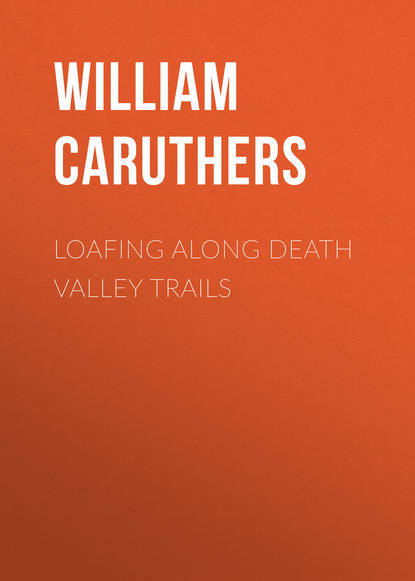По всем вопросам обращайтесь на: info@litportal.ru
(©) 2003-2024.
✖
Loafing Along Death Valley Trails
Настройки чтения
Размер шрифта
Высота строк
Поля
When the votes were counted the overlords of the west side gasped. “Who the hell’s this Brown? Didn’t even know he was running…”
Taking office January 1, 1925, he found that the beaten incumbent had spent all the money allocated for road maintenance in his own bailiwick before retiring. Nevertheless, Brown convinced the new board his election proved that the people of the entire county agreed with him that the Death Valley area could no longer be neglected and managed to get a niggardly appropriation which would not have built a mile of decent mountain road, and his district had three challenging mountain ranges to cross.
With this appropriation he was expected to care for a mileage four times greater than that of the west side and was thus responsible for not only eastern approaches but maintenance of 150 miles of road from Darwin, all roads in the valley and those which furnished the north and south approaches. He managed to get $5000 after two years. With this he procured road machinery on a rental basis and succeeded in making a fair desert road. Then he began a one-man crusade to exploit Death Valley as a tourist attraction. “We need only roads a tourist can travel.”
He worked just as diligently for all of Inyo’s roads. “We have one of the world’s best vacation lands,” he told the west-siders. “You have an abundance of beautiful lakes and streams in a setting of mountains impressive as any in the world. On our side we offer the appeal of the Panamint, the Funeral Range, and spectacular Death Valley. Tourists will come to both of us if we give them a chance and they will be our best crop.”
By 1926 his crusade for roads had spread beyond Inyo county lines. San Bernardino county, through which passes Highway 66, a main transcontinental artery, joins Inyo on the south. Its board of supervisors was in session one day when Brown strode in. Most of them he knew. He wanted their advice, he told them. “Your county and mine need more roads to bring more people. The easiest way into Death Valley is through your county from Baker. The distance from Baker to the Inyo county line is 45 miles. If you will build the road to the Inyo line, I will build it from that point to Furnace Creek, 71 miles. Such a road would open Death Valley to the public and the tourists who will travel will spend enough money in your towns to pay your share of the cost.”
San Bernardino supervisors agreed to consider it but were not enthusiastic. One of America’s largest counties, San Bernardino had also one of its largest road problems.
Brown kept plugging, arranging meetings, convincing residents that the county’s portion of the road would be over flat country and over roads already passable, and its construction inexpensive.
Finally San Bernardino county supervisors agreed and by April, 1929, he had 71 miles of passable road. The result was that Death Valley was no longer remote as the Congo and tourists began to come.
To Shoshone it meant a few more windshields to wipe; a few more cars to crawl under. Another soft answer to frame for the sightseer cursing the desolation. Another shed for the store that started on the kitchen table.
In 1932 Brown went before the State Highway Commission and urged that all the roads he had built in Death Valley be taken over by the state. The law was passed.
Death Valley became a National Monument February 11, 1933, by order of President Franklin Roosevelt. At that time America was groping its way through depression, worrying about its dinner and its debts as a result of the stock market crash of 1929.
In the nation’s hobo jungles the seasoned “bindle stiff” made room for the newcomer who had always lived on the right side of the tracks. Freight trains carried a new kind of bum when the adolescent female crawled into a car alongside an adolescent male, vainly seeking work anywhere at anything.
To save them and others like them C.C.C. camps were organized and one of these recruited largely from New York City’s Bowery, was sent to Death Valley with headquarters at Cow Creek, a few miles north of Furnace Creek Inn.
The new park was under the supervision of Col. John R. White, later superintendent of the entire National Park System and to Ray Goodwin, assistant superintendent was assigned the task of building additional roads and trails to points of interest to connect with the State System which Brown had built.
Then began in earnest the flow of tourist traffic to the “God-forsaken hole” for which Brown had worked for 14 long and difficult years. But he soon found that to the problems of a small desert community he had added those of a whole county. They were the aftermath of what has since been called in a marvelous understatement by Morrow Mayo, historian of Los Angeles, “The Rape of Owens Valley.”
In the early part of the century, the city of Los Angeles had secretly acquired nearly all sources of water in Inyo and Mono counties. An amazed world applauded the engineering feat by which water was siphoned over mountain ranges to flow through ditches and tunnels, a distance of 259 miles.
The enterprise was announced by its promoters as the answer to the desperate need for water. It is now known that this need was only a mask to hide a scheme to make Los Angeles pay the cost of bringing water to 108,000 acres of waterless land in San Fernando valley so that the owners could make a profit of a hundred million dollars through its subdivision and sale. This they did.
The shameful story glorifies by comparison the cattle wars of the early West when one side hired its Billy the Kids to kill off the other – the only difference being that in the Owens Valley feud the Billy the Kids were the Big Names of Los Angeles who used unscrupulous politicians and laws cunningly passed instead of six-guns.
As a consequence, Los Angeles owns the towns, ranches, and cattle ranges so that merchants, householders, ranchers, and renters have no title except in a relatively few instances, to the land upon which they live or to the house or store they occupy. Los Angeles could sell or lease or refuse to sell or lease land to cattlemen, homes to residents or stores to merchants and sell or refuse to sell water to those who had lived all their lives and would die on the devastated land.
As a result, the relations between the city and the Displaced Persons of the two counties were those of victor and vanquished.
In 1935 the city succeeded in getting an act passed by the legislature which prevented any town from becoming incorporated without the consent of 60 per cent of the property owners. The purpose of the act seemed fair enough when it was announced that it was designed to save the towns from both political demagogues and crackpots running amuck in California and it became a law.
But there was more than the eye could see. Its real object had been to strengthen the strangle hold of the Los Angeles Water and Power board upon Owens Valley. Since it owned the towns it could now prevent their incorporation. There had been some feeling of security under a resolution of the Water and Power Board which had declared that merchants, cattlemen, and residents – all of them lessees, would be given preference in new leases and renewals of old ones.
In 1942 the resolution became a scrap of paper, and ranchers, cattle men and householders were advised that their leases would hereafter be renewed by a method of secret bidding.
Thus the residents of Owens Valley learned that the labor of years had brought no security. As one beaten old timer told me, “We’ve been kicked around so much I’m used to it. I helped blow those ditches two-three times, to turn that water loose on the desert. I know when I’m licked.”
Resentment in Mono county, which provided more of the water taken by Los Angeles than Inyo, was even more aroused and smoldering hatreds were ready again to blow up a ditch. The two counties constitute the 28th Senatorial district.
Brown’s success in the Assembly had not gone unnoticed in the neighboring county of Mono. “We need that fellow Brown,” a prominent citizen said, and others repeated it.
Again Charlie put his suitcase in his car, filled the tank. “We’ve never had anybody from this side at Sacramento,” he told a friend standing by. “I’m running for the Senate.”
“Know anybody up there?”
“I’m going and get acquainted,” he said and headed across the valley.
Most of Mono county is isolated by the High Sierras. Again the door to door technique. No torches. No brass bands. Just the old eye-to-eye-talk-it-over system. As always he let the voter do the talking and he listened, but when he slid into his car the voter was ready to tell his neighbor: “I like that fellow. Doesn’t claim to know it all.” He told his banker, his grocer, his butcher, baker, and barber.
Result? I was in the Senate Chamber at Sacramento later, when I heard one of a group of men huddled nearby say, “This is an important bill that concerns everybody on the east side of the Sierras. We’d better see Charlie.” I nudged the man reading a document at my side. “Those fellows want to see you, Senator.”
He had received the nomination of both the Democratic and Republican parties and had secured the passage of an act which denies a municipality holding more than 50 per cent of the property of another subdivision of the state, proprietary power over the security and stability of such subdivision. Moreover he was on the all-powerful Rules Committee, the Fish and Game, Local Government, Natural Resources, Social Welfare, and Election Committees, friend and frequent adviser of Governor Warren.
Honeymooning Secretary Ickes was combining business with pleasure when he reached California and wanting to see how his Park System was functioning, he took his bride to see Death Valley. Besides, he had some plans affecting the Inyo area.
The fight was having tough sledding in the legislature despite President Roosevelt’s approval. Then he talked to people less biased. “You’d better see Charlie…”
“Who the hell’s Charlie?” asked Harold.
“Senator from Death Valley…”
With Ray Goodwin, Superintendent of the Death Valley Monument to guide him, he was taken to all the show places. “Now,” said Mr. Ickes, “I want to see Brown.”
At Shoshone Charlie’s toggery is strictly for work which includes tending the gas pump, stove repairing, plumbing, and what-have-you. He was flat on his back under the dripping oil of a balky car when Mr. Goodwin stepped from the limousine.
“Charlie,” Mr. Goodwin called, “Mr. Ickes is here to see you.” Receiving no answer, he walked over to the car and added that Mr. Ickes was in a hurry. Still, no answer. “It’s Secretary Ickes, Department of the Interior. This is important.”
“So’s this,” Brown grunted. When he’d finished, he crawled out and wiping the grime from his hands, joined Goodwin at the waiting car. After being introduced to the bride and the self-styled “Old Curmudgeon” the latter explained his plan to add certain lands in Charlie’s district, to the Forest Reserve. “… You’re opposing me. You’re a Democrat, aren’t you?”
“I came from Georgia,” Charlie drawled.
“You’re for Roosevelt, aren’t you?”
“Within reason,” Charlie answered.
Then Mr. Ickes, with the assurance of the perfectionist began to sell his idea.
“Do you know of any reason why the area designated as Forest Reserve should not be protected as any other of our natural resources?” he concluded.
“Just one,” Charlie said.
“What’s that?” Ickes snapped.
“Your forest is nearly all brush land without a tree on it big enough to shade a lizard.”
Charlie was similarly dressed when a well tailored and impatient tourist with a carload of friends whom he was evidently trying to impress, drove up for gas.
Always unhurried, Charlie came to the pumps, slowly reached for the hose and as lazily checked the oil.







